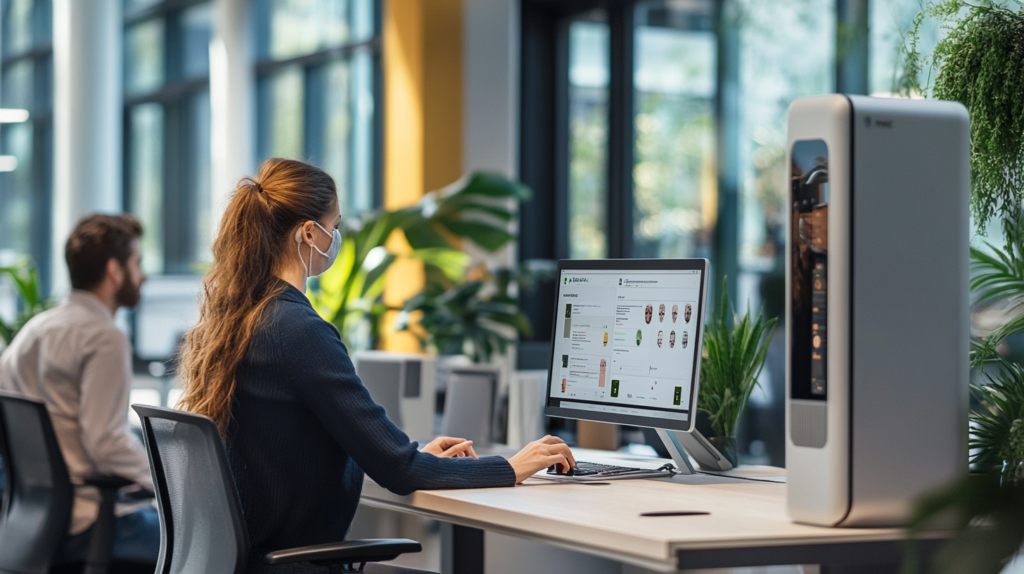How Biometric Time Clock Systems Improve Workforce Management

Biometric time clock systems have revolutionized the way businesses manage employee attendance and time tracking. By leveraging advanced biometric technologies, such as fingerprint and facial recognition, these systems offer a secure, efficient, and accurate method for recording work hours. In this article, we will delve into the various aspects of biometric time clock systems, explore their benefits, and discuss how they can enhance workforce management.
Table of Contents
- How Biometric Time Clock Systems Work
- Benefits of Using Biometric Time Clock Systems
- Types of Biometric Time Clock Systems
- Enhancing Workforce Management with Biometric Systems
- Security and Privacy Considerations
- Choosing the Right Biometric Time Clock System
- FAQ
How Biometric Time Clock Systems Work
Biometric time clock systems utilize unique biological characteristics, such as fingerprints or facial features, to verify an employee’s identity. This process begins when an employee clocks in by scanning their fingerprint or face, which the system then compares to the stored biometric data. If a match is found, the system records the time, ensuring precise and tamper-proof tracking of work hours.
Biometric Authentication Methods
There are several biometric authentication methods used in time clock systems, each offering varying levels of security and convenience. Fingerprint recognition is the most common method due to its ease of use and accuracy. Meanwhile, facial recognition is gaining popularity as it provides a touchless solution, which is particularly advantageous in today’s health-conscious environment.
Integration with Existing Systems
Biometric time clock systems can seamlessly integrate with existing payroll and HR software, streamlining administrative tasks. This integration allows for automatic updates to employee time records, reducing the likelihood of errors and ensuring that payroll processing is both accurate and efficient.
Benefits of Using Biometric Time Clock Systems
Employing biometric time clock systems provides numerous advantages for businesses, ranging from enhanced security to improved employee accountability. These systems eliminate the possibility of time theft, such as buddy punching, where one employee clocks in for another, thereby ensuring that only the rightful employee can log their time.
Eliminating Time Theft
Time theft can be a significant issue in many workplaces, leading to lost productivity and increased labor costs. Biometric time clock systems address this problem by making it impossible for employees to falsify their work hours, as the system requires their unique biometric data to clock in or out.
Improving Employee Accountability
With biometric time clocks, employees are held accountable for their attendance. The system’s accuracy ensures that employees cannot manipulate their work hours, leading to greater honesty and productivity in the workplace.
Types of Biometric Time Clock Systems
There are various types of biometric time clock systems available, each catering to different business needs. These include fingerprint time clocks, facial recognition time clocks, and hybrid systems that incorporate multiple biometric modalities.
Fingerprint Time Clocks
Fingerprint time clocks are the most widely used biometric systems. They are easy to implement, offer high accuracy, and are cost-effective. These clocks scan the unique patterns of an employee’s fingerprint to authenticate their identity, ensuring secure and reliable time tracking.
Facial Recognition Time Clocks
Facial recognition time clocks are gaining popularity due to their non-invasive nature. These systems use cameras to capture and analyze facial features, making them ideal for environments where hygiene is a concern. Additionally, they are often faster than fingerprint systems, as they can recognize individuals even when wearing masks or glasses.

Enhancing Workforce Management with Biometric Systems
Biometric time clock systems are not just tools for tracking time; they also offer valuable data that can enhance workforce management. By analyzing clock-in and clock-out patterns, employers can gain insights into employee behavior, such as punctuality and overtime trends, allowing for better scheduling and resource allocation.
Automated Attendance Tracking
One of the key features of biometric time clock systems is automated attendance tracking. This eliminates the need for manual timekeeping, reduces administrative workload, and minimizes errors. Automated reports can be generated for payroll processing, making the entire process more efficient and accurate.
Real-Time Monitoring
Biometric systems allow employers to monitor attendance in real-time, enabling them to address issues such as absenteeism or tardiness immediately. This capability is particularly useful in large organizations where managing attendance manually can be challenging.
Security and Privacy Considerations
While biometric time clock systems offer numerous benefits, they also raise concerns regarding security and privacy. It is crucial for businesses to implement measures that protect employee data and comply with privacy regulations.
Data Encryption
To safeguard biometric data, systems should employ strong encryption methods. This ensures that even if the data is intercepted, it cannot be accessed or used maliciously. Employers must also ensure that biometric data is stored securely and that access is limited to authorized personnel only.
Compliance with Privacy Laws
Businesses must be aware of and comply with privacy laws that govern the collection and use of biometric data. In many regions, laws require explicit employee consent before collecting biometric data and mandate that employees are informed about how their data will be used and stored.
Choosing the Right Biometric Time Clock System
Selecting the right biometric time clock system for your business depends on several factors, including the size of your workforce, the level of security required, and your budget. It’s important to evaluate different systems and choose one that meets your specific needs.
Evaluating System Features
When choosing a biometric time clock system, consider features such as ease of use, accuracy, and integration capabilities with your existing software. Look for systems that offer comprehensive reporting tools, real-time monitoring, and support for multiple biometric modalities.
Cost Considerations
The cost of biometric time clock systems can vary significantly based on the features offered. While it might be tempting to opt for a cheaper system, investing in a high-quality, reliable system can save money in the long run by reducing errors and improving overall efficiency.
FAQ
What is a Biometric Time Clock System?
A biometric time clock system is a device that uses biometric data, such as fingerprints or facial features, to verify an employee’s identity and track their work hours.
How Do Biometric Time Clocks Improve Security?
Biometric time clocks enhance security by ensuring that only the rightful employee can clock in or out, thereby eliminating the possibility of time theft or buddy punching.
Are Biometric Time Clocks Legal?
Yes, biometric time clocks are legal; however, businesses must comply with privacy laws regarding the collection, storage, and use of biometric data.
Can Biometric Time Clocks Integrate with Payroll Software?
Yes, most biometric time clock systems can integrate with payroll software, automating the transfer of time records and simplifying the payroll process.
What Are the Privacy Concerns Related to Biometric Time Clocks?
The main privacy concerns involve the collection and storage of biometric data. Businesses must ensure that data is encrypted, stored securely, and that employee consent is obtained.
Biometric time clock systems are revolutionizing workforce management by providing accurate, secure, and efficient time tracking solutions. Deskcove offers cutting-edge biometric time clock systems that integrate seamlessly with your existing software, enhancing your business’s operational efficiency. Explore Deskcove’s solutions today to find the right system for your needs.
